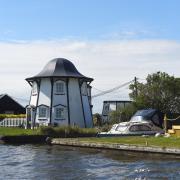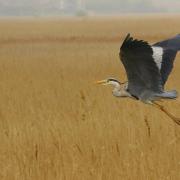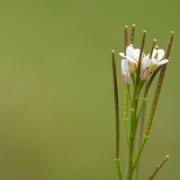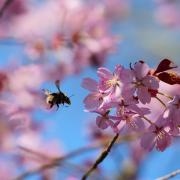The Norfolk Wildlife Trust ambassador takes us on a tour of Norwich’s new nature reserve, Sweet Briar Marshes – and discovers greenfinches, chiffchaffs, tree bumblebees and much more.
Yesterday (in late June, as I write) I led a walk. Ostensibly we were looking for plants, but I’m not known for sticking to the script. So there were greenfinches, chiffchaffs, tree bumblebees, a great spotted woodpecker and families of long-tailed tits along the way.

Plants though; oh, such plants we saw. My group and I were exploring Sweet Briar Marshes, Norfolk Wildlife Trust’s outstanding new reserve, just west of the centre of Norwich, along the River Wensum. I have written and spoken many times about Sweet Briar Marshes since – with support from local community groups – NWT decided to buy the site a couple of years ago. Now, thanks to overwhelming donations from our members and the public, and a partnership under which Norwich-based Aviva generously matched every pound given to our appeal, the site is ours.
Well, yours. That’s the point, isn’t it? At Norfolk Wildlife Trust we don’t purchase and manage nature reserves for ourselves. We do so for the glorious wildlife with which we share our county and our uniquely hospitable planet. And from the very start – almost 100 years ago, in 1926 – we have done so for our members and the people of Norfolk too. People and nature. Nature and people. It’s what we are.
But back to yesterday’s walk. One of the joys of Sweet Briar Marshes is the diversity of its habitats. Within a small space – just 90 acres, surrounded by housing and an industrial estate – Sweet Briar Marshes holds dry, sandy grassland; hawthorn and blackthorn scrub (loud in spring with cuckoos and with warblers); patches of older oak woodland; and marshes teeming with life.
We walked first through the drier grassland yesterday, along the edge of Marriott’s Way. Already parched by early summer’s long, dry weeks, only the hardiest of flowers were blooming here. Clouds of perforate St-John’s-wort shone along the path, dappled by the quiet pink of musk mallow. Here and there the sulphur spires of hoary mullein reached for the clouded sky and wild carrot’s constellations were starting to unfurl.

The real joy, though, lay in the marshes by the river. Here, among lush beds of reed sweet grass, reed canary grass and wavy hair grass, we found countless treasures of lost Norfolk landscapes. And – as my excitement rose – my poor group was forced to greet each plant in turn. ‘Tubular water dropwort!’ I cried, making them crouch to admire its pipe-like stems and lacy flowers. ‘Look! Among that drift of southern marsh orchids, there’s an early marsh orchid. Can you see its softer pink? Look how the flower’s lower lip curls backwards, as though shy.’
Everywhere there was something to delight in: curtains of frothy, pinkish common valerian along ditches; common fleabane in ruts where water sits in winter; purple loosestrife shooting into vibrant bloom. ‘Lesser spearwort!’ I squealed, diving into the marsh for a closer look. ‘And that tree there, with sandpapery, lopsided leaves; that’s wych elm.’
‘Crouch down here. Feel the stem. This one is square-stalked St-John’s-wort, which likes fens and marshes. Feel its stem!’ When our two hours’ botany were done, we all agreed we needed two hours more: feeling the unexpected bristliness of rough chervil; savouring the repugnant scent of hedge woundwort; checking the tips of leaves for mucros – for botanists do love arcane terminology – to confirm a plant’s identity as marsh bedstraw.
For two hours, 15 of us were united in our focus on the lives and looks of plants. United too in our unspoken commitment to Sweet Briar Marshes and its protection: for the scarce species which inhabit it and for people to enjoy it, study it, understand, interpret and embrace it.
Sweet Briar Marshes is a nature reserve for everyone in Norwich and in Norfolk, and especially for the people who live close by. Once formally opened, later this year, it will be for schools and colleges and community groups. It will be for local walking groups, for art groups and for nature groups. It will be for young people, taking breaks from studying for their exams. For old people, remembering the wilder, freer landscapes of their childhoods. For families of every shape and kind. And it will be for you.

Sweet Briar Marshes is also – how much of our dastardly plan should I reveal? – our secret agent. Both on the birdsong walk I led there in the spring, and on yesterday’s wildflower walk, I saw how powerfully nature acts on people’s minds and moods. How could anyone hear a cuckoo or learn a lesser whitethroat’s rattling song – right in the city of Norwich – and not be heartened by nature’s beauty and resilience, and inspired to act for its recovery? How could anyone crouch to see the sunny little flowers of rare marsh ragwort and not vow to be an advocate for wildlife?
Sweet Briar Marshes is a secret agent in our plan to rewild Norwich, helping nature flourish beside humanity, just as it did for centuries in our Fine City. Between our precious reserves at Thorpe Marshes and Sweet Briar Marshes we want to see a riot of action on behalf of nature; a profusion of gardens, parks and playing fields leaving space for wildlife; small armies of children, families, teachers, businesses and CEOs making space for nature in the places they control.
So be careful. If you come to Sweet Briar Marshes with me – or with any of my inspiring colleagues at Norfolk Wildlife Trust – you will quickly find you’re swooning over the tiny stars of lesser stitchwort, teasing away the leaves of curled dock to see its fleshy stipules, and looking up admiringly at buzzards circling over head. You will find yourself inspired to look for nature everywhere in Norwich. And – who knows? – maybe even to act with us for nature too.
Sweet Briar Marshes will be open to the public later in 2023. To find out more about our work with surrounding communities to develop Sweet Briar Marshes as an urban nature reserve, visit norfolkwildlifetrust.org.uk/sweetbriar



























